Root Foods, Geophytes
Historical records indicate that several root foods sustained the native groups of the South Texas Plains, particularly during the winter. The enduring mystery remains, "What kinds of roots were they?" In fact, we simply don't know . . . yet. There are, however, several candidates which we will discuss.
We first need to explain what we mean by "root foods". Common usage for the word root actually refers to several different parts of a plant. For example, onions are often referred to as root foods, but in fact an onion bulb consists of thick, fleshy leaves arranged in a rosette around a short stem. The leaves are modified to contain food, and the bulb just happens to grow underground. The potato is a tuber, which is a root that is modified for food storage. The cattail (or tule) stores food in a rhizome, which is an underground shoot or stem.
A more appropriate and inclusive word is "geophyte", which refers to any plant that stores food in an underground organ, be it a bulb, tuber, rhizome, or corm. These organs function to store food reserves, nutrients, and moisture for seasonal growth and development enhancing a plant's ability to overwinter or survive long periods of drought. From a hunter-gatherer's viewpoint, these plants are miniature energy packets for any predator that happens along. The problem that roots pose for potential foragers is that they usually contain biochemicals that discourage comsumption, such as alkaloids or saponins. They require lots of processing to neutralize these chemicals.
History's Little Mysteries: Root Foods. Although Spanish observers mention root foods, they seldom identify them. However, reviewing their observations helps to eliminate some roots and home in on others. The most often mentioned, and perhaps the most detailed account is from Cabeza de Vaca's Relación. The Mariames relied on roots for much of their diet, according to Cabeza de Vaca, the first European to trek across Texas and Northern Mexico, in the early 16th century.
Their food supply is principally roots of two or three kinds and they look for them through all the country; these are very and swell the men that eat them. They [the roots] take two days to roast and many of them are bitter, and on top of this it is with great labor that they are dug out (Krieger 2002:194).
As Cabeza de Vaca observed, these unnamed roots required a long period of cooking, and even then they tasted bitter and were hard on the stomach.
In the 17th century, friars supervising at two mission-settlements, Santa Rosa and San Idelfonso in Coahuila, subsisted on "mescal and roots". Among these so-called root foods were the root-like rhizomes of tule or cattail, Typha spp. However, the other root foods remain unnamed (Wade 2003:9-10).
Alonso de Leon's mid 17th century observations in northern Mexico also note that the native groups depended on root foods.
There are many kinds of wild fruits, present all over the Province (Nuevo Leon), so that in the summer they eat the fruits, in the winter the roots, and then they go about like hogs, venturing into the field to collect them, and carry a large quantity (Duaine cited in Brown 1988:9).
The reference to hogs appears to refer to the process of digging the roots out of the ground, an activity that would leave a small field full of pits just as if hogs, javelina, or armadillos were working through the area. At least De Leon's observation leaves us with a season, the winter. Cabeza de Vaca is less exact about the season, but he notes that the root digging occurred before the prickly pear fruits were ripe. The following vignettes will briefly review some of the possibilities for root foods growing in the South Texas Plains.
Wild Onion ( Allium spp. )
We don't have historical observations of onion use in the South Texas Plains or adjacent Mexico. However, onion happens to be the root food for which we have the most archeological and ethnographic information from other areas in the Southwest and the Plains. The small bulbs of the genus Allium, known commonly as wild onion or wild garlic, grow throughout the South Texas Plains and may have been an important seasonal food source for native peoples. Wild onions grow most densely on relatively well-watered terraces along streams and rivers, but can be found widely. There is growing archeological evidence that wild onions were harvested in bulk and baked in earth ovens.
Archeology. Onion fragments are quite common in the well-preserved rockshelter or cave deposits of the Lower Pecos. In Hinds Cave, the only rockshelter site for which we have quantitative data, onion remains were the third most commonly occurring edible plant part in an Early Archaic context, and the fifth most commonly occurring in the Late Archaic context (Dering 1999:663). These data suggest that bulbs were consumed in large quantities, not a condiment but as a staple. The coprolite data also confirm the importance of wild onion, where in one study it was noted in 40% of the coprolites (Williams-Dean 1978), and in another study over 55% of the coprolites (Stock 1983). Within the past year fragments of charred bulbs, probably onions, were identified from an archeological site in Uvalde County (Dering 2005). More research in the South Texas Plains will undoubtedly uncover more evidence for the use of root foods.
Food. Proximal analysis of fresh Drummond onion bulbs note that they contain 70% water, 1.7% reducing sugar, and 18.1% non-reducing sugar (Yanovsky and Kingsbury 1938). The non-reducing sugar represents long-chain carbohydrates, primarily inulin, which humans cannot digest. Inulin has to be exposed to heat for long time periods to be converted to digestible sugars, and baking in an underground pit is the most widespread technique that Native Americans utilized for this purpose.
There are no ethnographies available from the South Texas Plains, but ethnographic observations from the greater Southwest and the Plains abound for wild onion. They mention Allium as an addition to other dishes, primarily meat, or simply mention that it was used for food. Regarding Allium drummondii, the Lakota (Rogers 1980) used the bulb for "food", the Cheyenne and Pawnee, as an addition to meat dishes (Gilmore 1977; Grinnel 1972). The Ramah Navajo boiled meat along with onion bulbs (Vestal 1952). In California, there are references to more intensive use of onion. Other species were similarly used; the Western Apache boiled blood in a deer stomach with onions for flavoring (Buskirk 1986).
Barrett (1952:89) notes that the Pomo of northern California baked onions in an underground oven. The Surprise Valley Paiute collected Allium in large quantities, two to five sacks at a time. They dug a pit and built a fire of unspecified size to which they added small stones. The food load was placed in the oven, covered with grass and earth, and left overnight (Kelly 1933:102).
The economy of both the Paiute and the Pomo focused much more on gathering plants than either hunting or farming. This may be why they were still utilizing wild onions more as a main dish, rather than a condiment. On the Edwards Plateau, it is likely that the Native Americans were using wild onions both as a primary, but seasonal source of carbhohydrates, and as a supplement.
Tule, Cattail (Typha spp. )
Introduction. Cattail grows in standing water or along streamsides and seasonally inundated soils. The long, flat, and narrow leaves emerge from sturdy rootstalks, extending vertically for up to 10 feet. The stem and roots at the base of the plant are white, pithy, and store large quantities of starch, as do the many rhizomes that connect each plant.
Native Americans utilized virtually every part of the cattail. The roots provided a source of starch; the leaves were woven into containers. Cattails are prolific pollinators, and the flowers and pollen were consumed and utilized for ceremonial purposes.
Archeological occurrence: Only cattail pollen has been reported from archeological sites in Texas. Accidentally ingested background cattail pollen appears in most of the coprolites analyzed from the Lower Pecos River (Sobolik 1991; Williams-Dean 1978), but at relative percentages below 5%. One coprolite in the Williams-Dean (1978) study registers 11.5%, and this may indicate ingestion of cattail flowers.
Food: In addition to the 17th century reports of cattail use by Spanish friars living just south of Eagle Pass (Wade 2003), there is widespread ethnographic evidence originating from the greater Southwest. A short list of desert dwellers that utilized cattail include the Western Apache, Pima, Papago, Cahuilla, Maricopa, Mohave, Cocopa, Kamia, Paipai, and many others. The seeds, roots, basal stems, and rhizomes provided a source of starch, the leaves provided material for trays and other types of basketry, and the flowers and pollen had symbolic functions in many rituals.
The Western Apache dug the roots and the base of the tule stem out of the water and roasted them for food. Tule flowers were eaten for the pollen, which has a highly concentrated caloric content. The White Mountain Apache and the Northern Tonto ate the white tips of young tule shoots. The Cibecue at the cattail flower buds raw. The White Mountain, San Carlos, and Cibecue ate the white stem bases as well. During the early 20th century cattail pollen was gathered and put in bottles for sale at the swampy lakes north of Cibecue (Buskirk 1986:193). The Navajo ate the white young stalks and rhizomes raw in the summer (Vestal 1952:14).
Other uses: Havasupai and the Kawaiisu used cattail leaves for thatching roofs and walls of houses (Weber et al. 1985; Zigmond 1981). The Northern Paiute applied cattail leaves in such diverse applications as building construction, fabrication of sandals and other clothing, and construction of boats (Fowler 1990). The Pima wove the leaves into mats and used the split flower stalks for weaving baskets (Curtin 1984:64-65).
The The Ramah Navaho used cattail leaves for storage and medicin baskets, bed mats, and coiled mats.
Medicine and ritual: The Mescalero Apache used cattail pollen as general curative agent (Basehart 1960). The Cahuilla, Omaha, and Pawnee used the root in poultice or powered form as a topical ointment for burns and bleeding wounds (Bean and Saubel 1972; Gilmore 1977). The down from the flowering stalk was used as a powder for chafing (Gilmore 1977).
Other Roots
We can only speculate on the other root foods of the South Texas Plains. The following plants have little or no ethnographic documentation, and there is no archeological or historical documentation from the South Texas Plains. Only more research will be able to confirm or refute the roles that these plants played as food and/or medicine in the lives of the native groups of the region.
Because roots are often loaded with toxic substances as a defense against predation, absolutely do not try, under any circumstances, to sample them. I do so carefully and only under a stringent protocol. To do otherwise could cause serious harm or death.
Globeberry -- Ibervillea lindheimeri
Globeberry is a trailing or climbing, vine-like plant that gets its name from the bright red spherical fruit that ripens in mid- to late- summer. The plant is very common throughout the South Texas Plains, and it has a very large tuber that is difficult to dig out of the ground). Thanks to the large tuber, globeberry is remarkably drought resistant, and is one of the few plants that bloom and fruit during extremely dry summers. The bright red berries stand out against a parched landscape, and this quality alone would make the plants visible to foragers.
Globeberry is so poorly known that I haven't tried to eat the root yet, and I don’t suggest that anyone else try it either. After tasting the berry, the most I can say is that it didn't taste like it could poison me, and I lived to write this vignette. But that's not always the only indication of danger. The tuber fits Cabeza de Vaca's description in that it is large and difficult to dig because it's usually deeply buried in dense, silty, clayey, or rocky soils. I have a hard time digging them with a steel pick, and I can only imagine what it is like to grub one out of the ground using a persimmon or mesquite branch for a digging stick.
False Garlic/Crow Poison -- Nothoscordum bivalve
Crow poison is a small, onion-like plant . There are no ethnographic records for this plant. However, when pit-baked, the bulb is virtually tasteless, and I doubt that the baked version is dangerously poisonous. It's caloric content, which is 212 kcal/100 g dry-weight, is somewhat lower than other bulbs or agave which average 270 kcal/100g or higher. Yet false garlic grows in such high density in some areas that it may have been available as a seasonal staple.
Peonía, Desert Peony -- Acourtia rucinata, Perezia rucinata
This small plant is not edible but it has potential medicinal applications. Peonía is common along stream terraces and even uplands in the western Rio Grande Plains and also grows in the southern parts of the region. Essentially stemless with basal leaves, peonia has a tuberous root and develops woolly tufts around ripening flower heads . Although there are no ethnographic observations of peonía, I have used the flower/fruit tufts and the sap of the root, as an astringent and they very useful for stopping bleeding. One relative of this plant, Acourtia wrightii, is also a perennial herb that is a little taller than peonia because it has a stem, is mentioned as being useful for the same purpose. The Pima used Acourtia wrightii to stop bleeding (Russell 1908). The Cahuilla claimed that a decoction of Acourtia microcephala was a very strong laxative, a use that I haven't tested (Bean and Saubel 1972).
References
Barrett, S. A.
1952 Material Aspects of Pomo Culture: Part One. Bulletin of the Public Museum of the City of Milwaukee 20:1-260.
Bean, Lowell J. and Katherine S. Saubel
1972 Temalpakh: Cahuilla Indian Knowledge and Usage of Plants. Malki Museum Press. Morongo Indian Reservation, Banning, California.
Brown, Ken
1988 Some Annotated Excerpts from Alonso De León's History of Nuevo León. La Tierra 15:5-20.
Buskirk, W.
1986 The Western Apache: Living with the Land Before 1950. University of Oklahoma Press. Norman.
Curtin L. S. M.
1984 By the Prophet of the Earth: Ethnobotany of the Pima. Reprint of book published by San Vicente Foundation [1949]. University of Arizona Press. Tucson.
Dering, J.P.
1999 Earth-oven Plant Processing in Archaic Period Economies: An Example from a Semi-Arid Savannah in South-Central North America. American Antiquity 64(4): 659-674.
2005 Plant Remains from 41UV83. Manuscript submitted to Hicks and Company, Inc. Ausin, Texas.
Fowler, Catherine S.
1990 Tule Technology: Northern Paiute Uses of Marsh Resources in Western Nevada. Smithsonian Institution Press, Washington, D.C.
Gilmore, M.R.
1977 Uses of Plants by the Indians of the Missouri River Region. University of Nebraska Press. Lincoln.
Grinnell, G. B.
1972 The Cheyenne Indians - Their History and Ways of Life Vol.2. Lincoln. University of Nebraska Press.
Kelly, Isabel
Ethnography of the Surprise Valley Paiute. University of California Publications In American Archaeology and Ethnography 31:67-210.
Rogers, D. J
1980 Lakota Names and Traditional Uses of Native Plants by Sicangu (Brule). People in the Rosebud Area, South Dakota.Rosebud Educational Society.St. Francis, S.D.
Russell, Frank
1908 The Pima Indians. In Twenty-sixth Annual Report of the Bureau of American Ethnology, No. 26. [1904-1905], pp. 17-389. Washington, D.C.
Sobolik, K. D.
1991 Prehistoric Diet and Subsistence in the Lower Pecos as Reflected in Coprolites from Baker Cave, Val Verde County, Texas. Studies in Archeology 7. Texas Archeological Research Laboratory. The University of Texas at Austin.
Stock, J. A.
1983 The Prehistoric Diet of Hinds Cave, Val Verde County, Texas. Department of Anthropology, Texas A&M University, College Station, Texas.
Vestal, P. A.
1952 The Ethnobotany of the Ramah Navaho. Papers of the Peabody Museum of American Archaeology and Ethnology 40(4):1-94.
Wade, Maria
2003 The Native Americans of the Texas Edwards Plateau. University of Texas Press. Austin, Texas.
Weber, Steven A., P. David Seaman
1985 Havasupai Habitat: A.F. Whiting's Ethnography of a Traditional Indian Culture. University of Arizona Press. Tucson.
Williams-Dean, Glenna
1978 Ethnobotany and Cultural Ecology of Prehistoric Man in Southwest Texas. Anthropology Research Laboratory. Texas A&M University. College Station, Texas.
Zigmond, Maurice L.
1981 Kawaiisu Ethnobotany. University of Utah Press. Salt Lake City.
Yanovsky E. and R. Kingsbury
1938 Analyses of Some Indian Food Plants. Association of Official Agricultural Chemists 21(4):648-665.
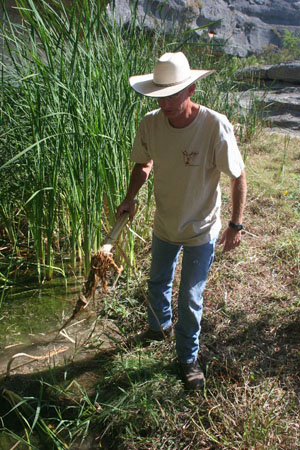
The author, J. Phillip Dering, examines a cattail, with rhizome and roots intact, pulled from the edge of a pond. Virtually all portions of this plant were used by native peoples. |
Roots are often loaded with toxic substances as a defense against predation, absolutely do not try, under any circumstances, to sample them. I do so carefully and only under a stringent protocol. To do otherwise could cause serious harm or death. |
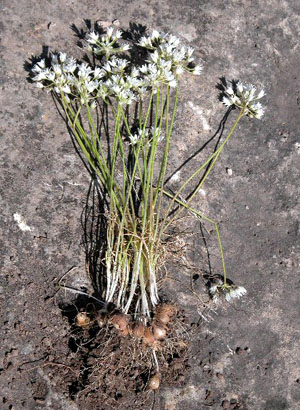
A bunch of freshly pulled wild onions. Native peoples cooked the small bulbs in bulk in earth ovens. |
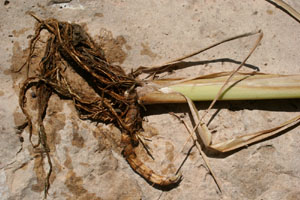
Cattail rhizomes. Native peoples used almost every part of this plant; the rhizomes are high in starch.
|
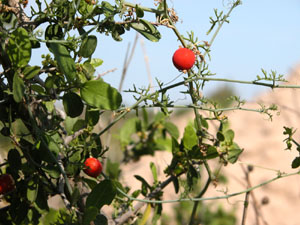
Red berries on the Globeberry vine. It is not known whether this berry or other parts of the plant are edible.
|
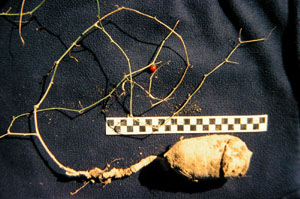
Globeberry tuber.
|

False garlic, or crow poison
|
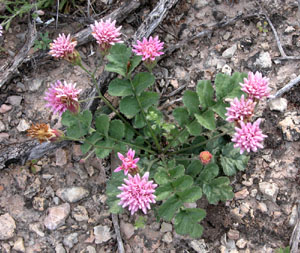
Acourtia or Perezia plant, also known as Peonia. |
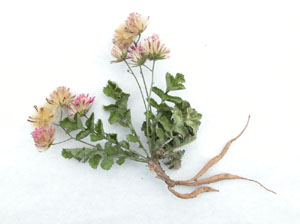
Acourtia-Perezia root. The plant is not edible, but has ben used for medicinal purposes.
|